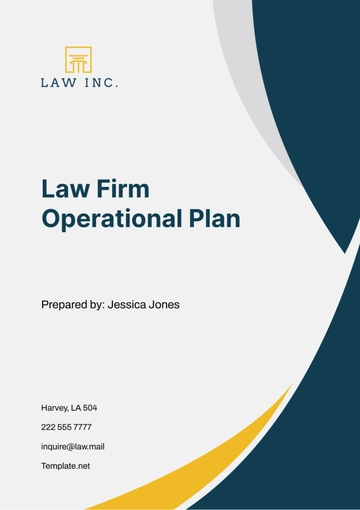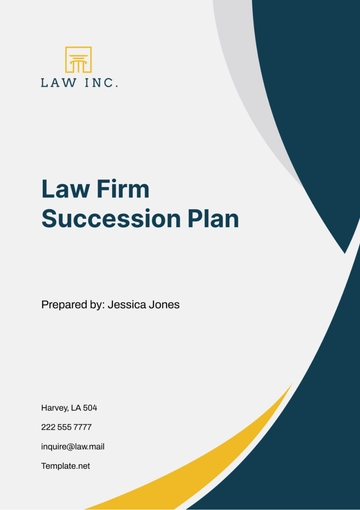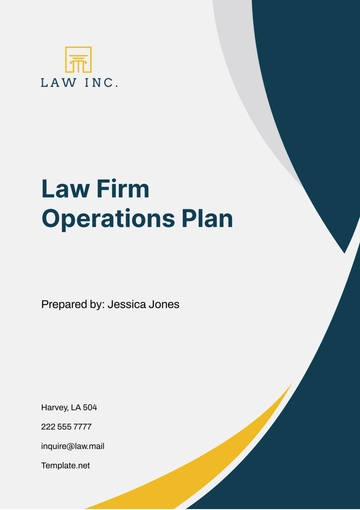Free Law Firm Management Plan

I. Introduction
A. Overview
Purpose of the Law Firm Management Plan
The Law Firm Management Plan serves as a comprehensive roadmap for [Your Company Name]'s strategic direction, operational efficiency, and client service excellence. This plan outlines our firm's mission, objectives, and key initiatives aimed at enhancing our competitive position in the legal industry while maintaining the highest standards of professionalism and integrity.
II. Executive Summary
A. Firm Overview
[Your Company Name] is a premier law firm headquartered in [City, State]. Established in [Year], we have emerged as a trusted legal partner for individuals, businesses, and organizations seeking expert guidance and representation across a diverse range of practice areas. With a team of [Number] attorneys and [Number] support staff, we offer comprehensive legal services tailored to meet the unique needs of our clients.
Our mission is to provide unparalleled legal expertise, innovative solutions, and personalized attention to every client we serve. By leveraging our collective experience, industry knowledge, and commitment to excellence, we strive to achieve the best possible outcomes for our clients while upholding the principles of integrity, diligence, and respect.
At [Your Company Name], we recognize the importance of building lasting relationships with our clients based on trust, transparency, and results. Whether navigating complex legal challenges, negotiating favorable settlements, or advocating in court, we are dedicated to protecting our clients' interests and helping them achieve their goals.
B. Key Objectives
Enhance Client Satisfaction: We are committed to exceeding client expectations by delivering exceptional legal services that address their specific needs and objectives. Through proactive communication, responsiveness, and strategic advice, we aim to foster long-term relationships built on trust and mutual respect.
Drive Profitability and Revenue Growth: We seek to optimize our firm's financial performance by maximizing revenue opportunities, controlling costs, and improving operational efficiency. By leveraging technology, innovation, and best practices, we aim to achieve sustainable growth and profitability in a competitive market.
Foster a Culture of Collaboration and Excellence: We believe in the power of teamwork, collaboration, and continuous improvement. By investing in our people, promoting a supportive work environment, and recognizing individual contributions, we aim to attract, retain, and develop top talent who share our commitment to excellence.
Enhance Reputation and Visibility: We are dedicated to enhancing [Your Company Name]'s reputation as a leading legal authority and trusted advisor in our areas of expertise. Through strategic marketing, thought leadership, and community engagement, we aim to raise awareness of our firm's capabilities and achievements, both locally and globally.
C. Strategic Initiatives
Implement Technology Solutions: To streamline our operations and enhance client service delivery, we will invest in cutting-edge technology solutions, including practice management software, document automation tools, and client communication platforms. By leveraging technology, we aim to improve efficiency, accuracy, and accessibility while staying ahead of emerging trends and client expectations.
Expand Marketing Efforts: To attract new clients and retain existing ones, we will develop and execute targeted marketing campaigns across various channels, including digital, social media, and traditional advertising. By showcasing our firm's expertise, achievements, and client success stories, we aim to differentiate ourselves in the market and strengthen our brand presence.
Invest in Professional Development: To empower our team members to reach their full potential, we will provide ongoing training, mentorship, and professional development opportunities. By investing in our people's skills, knowledge, and career growth, we aim to enhance employee engagement, job satisfaction, and overall firm performance.
Promote Diversity and Inclusion: We are committed to fostering a diverse and inclusive workplace where everyone feels valued, respected, and empowered to succeed. Through recruitment initiatives, diversity training, and inclusive policies, we aim to cultivate a culture of belonging where individuals from all backgrounds can thrive and contribute to our firm's success.
III. Firm Governance
A. Leadership Structure
Managing Partner: [Your Name]
Responsibilities:
Oversees day-to-day operations and strategic direction of the firm.
Chairs Management Committee meetings.
Serves as the primary liaison with external stakeholders.
Management Committee:
Comprised of key partners.
Responsibilities:
Assists the Managing Partner in decision-making and policy formulation.
Reviews financial performance and strategic initiatives.
Provides guidance on major firm matters.
Department Heads:
Responsible for managing specific practice areas.
Responsibilities:
Supervises attorneys and support staff within their department.
Ensures quality service delivery and client satisfaction.
Collaborates with firm leadership on departmental goals and objectives.
B. Decision-Making Processes
Major Decisions:
Made collaboratively by the Management Committee.
Input from department heads and key stakeholders is solicited.
Examples include strategic investments, lateral hires, and firm-wide policy changes.
Routine Operational Decisions:
Delegated to department heads and team leaders.
Examples include case assignments, staffing decisions, and client communication protocols.
IV. Practice Management
A. Client Intake and Case Management
Client Intake Procedures:
Initial client inquiries are logged into the firm's intake system.
Conflicts of interest checks are conducted to ensure ethical compliance.
Intake team evaluates the nature of the matter and assigns it to the appropriate attorney or department.
Case Management Systems:
Utilize [Case Management Software] to track case progress, deadlines, and client communications.
Each case is assigned a unique identifier for easy reference and retrieval.
Attorneys and staff have access to case files and relevant documents securely through the system.
B. Billing and Finance
Billing Procedures:
Time entries are recorded accurately and promptly by attorneys and staff.
Invoices are generated monthly and reviewed for accuracy before issuance.
Billing statements include detailed breakdowns of services rendered, expenses incurred, and payment instructions.
Financial Reporting:
Monthly financial reports are prepared and reviewed by the Accounting Department.
Key metrics such as revenue, expenses, and profitability are tracked and analyzed.
Budget-to-actual comparisons are conducted to identify variances and adjust forecasts accordingly.
C. Risk Management
Risk Assessment Protocols:
Conduct regular risk assessments to identify potential liabilities and vulnerabilities.
Document and prioritize identified risks based on severity and likelihood of occurrence.
Develop mitigation strategies and contingency plans to address high-risk areas.
Malpractice Insurance:
Maintain comprehensive malpractice insurance coverage to protect the firm and its clients.
Regularly review policy limits and coverage options to ensure adequacy and compliance with regulatory requirements.
Collaborate with insurance brokers and legal counsel to address any claims or coverage issues effectively.
V. Human Resources
A. Recruitment and Hiring
Recruitment Strategy:
Utilize a multi-channel approach to attract top legal talent, including job postings, referrals, networking events, and recruiting agencies.
Emphasize the firm's values, culture, and opportunities for professional growth in recruitment materials and communications.
Proactively engage with law schools, bar associations, and professional organizations to identify potential candidates.
Hiring Process:
Initial screening of resumes and applications to identify qualified candidates.
Conduct comprehensive interviews with shortlisted candidates, including behavioral and skills assessments.
Perform background checks, reference verifications, and conflict of interest checks prior to extending offers of employment.
B. Training and Development
Orientation Program:
New hires participate in a comprehensive orientation program to familiarize them with the firm's culture, policies, and procedures.
Training sessions cover topics such as ethics and professional conduct, information security protocols, and client communication best practices.
Assign mentors to new attorneys and staff to provide guidance and support during the onboarding process.
Continuing Education:
Offer ongoing training and professional development opportunities to enhance skills and knowledge.
Provide access to internal and external resources, including CLE courses, workshops, and seminars.
Encourage participation in industry conferences, webinars, and thought leadership events to stay abreast of emerging trends and legal developments.
C. Performance Management
Performance Evaluation Process:
Conduct regular performance evaluations to assess individual and team performance against established goals and expectations.
Provide constructive feedback on strengths, areas for improvement, and career development opportunities.
Use performance data to inform compensation decisions, promotions, and succession planning initiatives.
Compensation and Benefits:
Offer competitive compensation packages, including base salary, bonuses, and benefits.
Provide opportunities for merit-based increases, bonuses, and incentives based on performance and contribution to the firm's success.
Maintain a comprehensive benefits package, including health insurance, retirement plans, and wellness programs to support employee well-being.
VI. Technology Infrastructure
A. Hardware and Software
Practice Management Software:
Utilize [Practice Management Software] to centralize case management, document storage, and client communication.
Features include time tracking, billing, calendaring, and task management for increased efficiency and organization.
Customizable workflows and templates streamline processes and ensure consistency across matters.
Document Management Systems:
Implement [Document Management System] to securely store, organize, and retrieve electronic documents and files.
Utilize version control and access controls to maintain document integrity and confidentiality.
Integrate with other software applications for seamless document sharing and collaboration.
B. Data Security and Privacy
Data Encryption:
Encrypt sensitive client data and communications to protect against unauthorized access and data breaches.
Utilize industry-standard encryption protocols and algorithms to safeguard information in transit and at rest.
Implement access controls and authentication mechanisms to restrict data access to authorized personnel only.
Security Audits and Compliance:
Conduct regular security audits and assessments to identify vulnerabilities and ensure compliance with regulatory requirements.
Address identified gaps and vulnerabilities promptly through remediation efforts and security updates.
Stay informed about evolving cybersecurity threats and best practices to proactively mitigate risks and protect client information.
VII. Marketing and Business Development
A. Branding and Messaging
Consistent Branding:
Maintain a cohesive brand identity across all marketing materials, including logo, color scheme, and messaging.
Ensure consistency in brand voice and tone across digital and print platforms to reinforce brand recognition and trust.
Messaging Strategy:
Develop clear and compelling messaging that articulates the firm's unique value proposition, strengths, and key differentiators.
Tailor messaging to resonate with target audiences and address their specific needs, challenges, and priorities.
B. Client Relationship Management
Client Feedback Mechanisms:
Implement feedback mechanisms, such as surveys, interviews, and feedback forms, to solicit input from clients.
Regularly review and analyze client feedback to identify areas for improvement and address concerns promptly.
Relationship-Building Activities:
Organize client appreciation events, networking opportunities, and educational seminars to foster relationships and deepen connections.
Share relevant industry insights, legal updates, and thought leadership content to provide value and stay top-of-mind with clients.
C. Business Development Strategies
Targeted Marketing Campaigns:
Identify target markets and segments based on industry, geography, or specific legal needs.
Develop tailored marketing campaigns and messaging to reach and engage prospective clients within these target markets.
Cross-Selling Initiatives:
Encourage collaboration and cross-referrals among attorneys and practice groups to leverage existing client relationships and expand service offerings.
Provide incentives and recognition for successful cross-selling efforts to encourage participation and alignment with firm goals.
VIII. Diversity and Inclusion
A. Policies and Programs
Diversity Statement:
[Your Company Name] is committed to fostering a diverse and inclusive workplace that reflects the communities we serve and the clients we represent.
We embrace and celebrate diversity in all its forms, including race, ethnicity, gender, sexual orientation, disability, and background.
Diversity Training:
Offer mandatory diversity and inclusion training for all employees to raise awareness, foster understanding, and promote inclusive behaviors.
Provide ongoing education and resources to support diversity and inclusion initiatives and address unconscious bias.
B. Recruitment and Retention
Recruitment Practices:
Implement inclusive recruitment practices, including outreach to diverse candidate pools, partnerships with affinity groups, and bias-free selection processes.
Evaluate recruitment metrics and outcomes to track progress and identify areas for improvement in diversity hiring.
Retention Strategies:
Create a supportive and inclusive work environment where all employees feel valued, respected, and empowered to contribute.
Offer opportunities for professional development, mentorship, and advancement to promote career growth and retention of diverse talent.
IX. Conclusion
A. Summary of Key Points
The Law Firm Management Plan outlines [Your Company Name]'s strategic objectives and initiatives to achieve growth, efficiency, and excellence in client service. Through a comprehensive approach to governance, practice management, human resources, technology, marketing, and diversity, we aim to position the firm for sustained success in a dynamic legal landscape.
By implementing the strategies outlined in this plan, we seek to enhance client satisfaction, drive profitability, foster a culture of collaboration and excellence, and elevate our reputation and visibility in the legal community. Through proactive leadership, innovation, and a commitment to continuous improvement, we are poised to deliver exceptional value to our clients and stakeholders.
B. Next Steps
The Management Committee will oversee the implementation of the Law Firm Management Plan, ensuring alignment with our firm's mission, values, and long-term objectives. Regular progress reviews and updates will be conducted to monitor performance, address challenges, and seize opportunities for growth and improvement.
As we embark on this journey, we recognize that success requires collective effort and dedication from every member of our team. By working together, supporting one another, and embracing change, we will realize our vision of becoming a leading legal institution known for excellence, integrity, and client service excellence.
- 100% Customizable, free editor
- Access 1 Million+ Templates, photo’s & graphics
- Download or share as a template
- Click and replace photos, graphics, text, backgrounds
- Resize, crop, AI write & more
- Access advanced editor
Achieve operational excellence with Template.net's Law Firm Management Plan Template. This editable and customizable document provides a structured framework for outlining goals, strategies, and responsibilities within your firm. Crafted by legal and management experts, it ensures clarity and professionalism in firm management. Editable in our Ai Editor Tool for seamless customization and integration into your firm's strategic planning process.
You may also like
- Finance Plan
- Construction Plan
- Sales Plan
- Development Plan
- Career Plan
- Budget Plan
- HR Plan
- Education Plan
- Transition Plan
- Work Plan
- Training Plan
- Communication Plan
- Operation Plan
- Health And Safety Plan
- Strategy Plan
- Professional Development Plan
- Advertising Plan
- Risk Management Plan
- Restaurant Plan
- School Plan
- Nursing Home Patient Care Plan
- Nursing Care Plan
- Plan Event
- Startup Plan
- Social Media Plan
- Staffing Plan
- Annual Plan
- Content Plan
- Payment Plan
- Implementation Plan
- Hotel Plan
- Workout Plan
- Accounting Plan
- Campaign Plan
- Essay Plan
- 30 60 90 Day Plan
- Research Plan
- Recruitment Plan
- 90 Day Plan
- Quarterly Plan
- Emergency Plan
- 5 Year Plan
- Gym Plan
- Personal Plan
- IT and Software Plan
- Treatment Plan
- Real Estate Plan
- Law Firm Plan
- Healthcare Plan
- Improvement Plan
- Media Plan
- 5 Year Business Plan
- Learning Plan
- Marketing Campaign Plan
- Travel Agency Plan
- Cleaning Services Plan
- Interior Design Plan
- Performance Plan
- PR Plan
- Birth Plan
- Life Plan
- SEO Plan
- Disaster Recovery Plan
- Continuity Plan
- Launch Plan
- Legal Plan
- Behavior Plan
- Performance Improvement Plan
- Salon Plan
- Security Plan
- Security Management Plan
- Employee Development Plan
- Quality Plan
- Service Improvement Plan
- Growth Plan
- Incident Response Plan
- Basketball Plan
- Emergency Action Plan
- Product Launch Plan
- Spa Plan
- Employee Training Plan
- Data Analysis Plan
- Employee Action Plan
- Territory Plan
- Audit Plan
- Classroom Plan
- Activity Plan
- Parenting Plan
- Care Plan
- Project Execution Plan
- Exercise Plan
- Internship Plan
- Software Development Plan
- Continuous Improvement Plan
- Leave Plan
- 90 Day Sales Plan
- Advertising Agency Plan
- Employee Transition Plan
- Smart Action Plan
- Workplace Safety Plan
- Behavior Change Plan
- Contingency Plan
- Continuity of Operations Plan
- Health Plan
- Quality Control Plan
- Self Plan
- Sports Development Plan
- Change Management Plan
- Ecommerce Plan
- Personal Financial Plan
- Process Improvement Plan
- 30-60-90 Day Sales Plan
- Crisis Management Plan
- Engagement Plan
- Execution Plan
- Pandemic Plan
- Quality Assurance Plan
- Service Continuity Plan
- Agile Project Plan
- Fundraising Plan
- Job Transition Plan
- Asset Maintenance Plan
- Maintenance Plan
- Software Test Plan
- Staff Training and Development Plan
- 3 Year Plan
- Brand Activation Plan
- Release Plan
- Resource Plan
- Risk Mitigation Plan
- Teacher Plan
- 30 60 90 Day Plan for New Manager
- Food Safety Plan
- Food Truck Plan
- Hiring Plan
- Quality Management Plan
- Wellness Plan
- Behavior Intervention Plan
- Bonus Plan
- Investment Plan
- Maternity Leave Plan
- Pandemic Response Plan
- Succession Planning
- Coaching Plan
- Configuration Management Plan
- Remote Work Plan
- Self Care Plan
- Teaching Plan
- 100-Day Plan
- HACCP Plan
- Student Plan
- Sustainability Plan
- 30 60 90 Day Plan for Interview
- Access Plan
- Site Specific Safety Plan





























